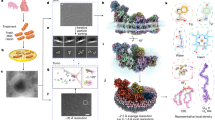Abstract
Several recent studies have shown that the lateral diffusion of erythrocyte transmembrane proteins is modulated by the sub-membrane network of spectrin, actin and polypeptide 4.1 (refs 1–3). The rate of lateral diffusion of the major transmembrane glycoprotein (the anion transport channel, band 3) is increased approximately 50-fold in membranes from spherocytic eryth-rocytes of mice which are deficient in the membrane skeletal protein spectrin1. Lateral mobility is increased when spectrin is removed from the membrane by extraction at low ionic strength2 or when it is displaced by a fragment of ankyrin containing the membrane attachment site for spectrin3. Such experiments show that the presence of spectrin on the membrane restricts the mobility of membrane proteins, but they do not define the mechanism by which spectrin could modulate membrane protein mobility in situ. The oxidant diamide has been shown to cross-link spectrin via intermolecular disulphide coupling into a high molecular weight complex4 and this is associated with inhibition of discocyte–echinocyte shape change5 and decreased erythrocyte deformability6. Here we report that the lateral mobility of band 3 protein is decreased in erythrocytes in which spectrin is cross-linked via diamide. Furthermore, this inhibition of mobility is reversed when spectrin oxidative cross-links are reduced by addition of dithiothreitol (DTT).
This is a preview of subscription content, access via your institution
Access options
Subscribe to this journal
Receive 51 print issues and online access
$199.00 per year
only $3.90 per issue
Buy this article
- Purchase on Springer Link
- Instant access to full article PDF
Prices may be subject to local taxes which are calculated during checkout
Similar content being viewed by others
References
Sheetz, M. P., Schindler, M. & Koppel, D. E. Nature 285, 510–512 (1980).
Golan, D. E. & Veatch, W. Proc. natn. Acad. Sci. U.S.A. 77, 2537–2541 (1980).
Fowler, V. & Bennett, V. J. supramolec. Struc. 8, 215–221 (1978).
Haest, C. W. M., Kamp, D., Plasa, G. & Deuticke, B. Biochim. biophys. Acta 469, 226–230 (1977).
Haest, C. W. M., Fischer, T. M., Plasa, G. & Deuticke, B. Blood Cells 6, 539–553 (1980).
Fischer, T. M., Haest, C. W. M., Stohr, M., Kamp, D. & Deuticke, B. Biochim. biophys. Acta 510, 270–282 (1978).
Palek, J. & Liu, S.-C. Red Cell Proc. 5th int. Conf. on Red Cell Metabolism & Function (ed. Brewer, G.) (Liss, New York, in the press).
Weinstein, R. S., Khodadad, J. K. & Steck, T. L. J. Cell Biol. 87, 209a (1980).
Fowler, V. & Branton, D. Nature 268, 23–26 (1977).
Huang, H. W. J. theor. Biol. 40, 11–17 (1973).
Schindler, M., Koppel, D. E. & Sheetz, M. P. Proc. natn. Acad. Sci. U.S.A. 77, 1457–1461 (1980).
Cherry, R. J., Burkli, A., Busslinger, M., Schneider, G. & Parish, G. R. Nature 263, 389–393 (1976).
Liu, S. C., Fairbanks, G. & Palek, J. Biochemistry 16, 4066–4074 (1977).
Laemmli, U. K. Nature 227, 680 (1970).
Author information
Authors and Affiliations
Rights and permissions
About this article
Cite this article
Smith, D., Palek, J. Modulation of lateral mobility of band 3 in the red cell membrane by oxidative cross-linking of spectrin. Nature 297, 424–425 (1982). https://doi.org/10.1038/297424a0
Received:
Accepted:
Issue Date:
DOI: https://doi.org/10.1038/297424a0
This article is cited by
-
Biophysical analysis of novel transport pathways induced in red blood cell membranes
The Journal of Membrane Biology (1987)
-
Direct covalent linkage of fluorescent probes to the plant protoplast surface
Protoplasma (1987)
-
Red cell membrane abnormalities in chronic myeloid leukaemia
Nature (1983)
Comments
By submitting a comment you agree to abide by our Terms and Community Guidelines. If you find something abusive or that does not comply with our terms or guidelines please flag it as inappropriate.



